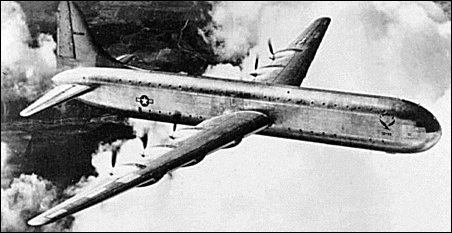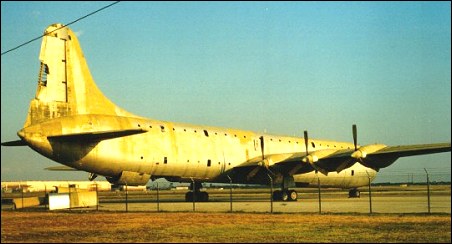 |
Convair XC-991947 |  |
| TRANSPORT | Virtual Aircraft Museum / USA / Convair |
 |
Max. speed 307mph, cruise 240-mph; ceiling 29,500 ft.; range 8,100 mi. Weights: 135,232 lbs. empty, 265,000 lbs. gross, 320,000 lbs. max. takeoff. Dimensions: Span 230 ft., length 182 ft. 6 in., wing area 4,772 sq. ft. In the darkest days of 1941, when the U.S. feared the possibility of being cutoff from bases outside the Western Hemisphere by victorious Axis forces, the AAF issued a requirement for an aircraft termed the "Intercontinental Bomber," capable of flying 8,000 miles with 10,000 lbs. of bombs. Consolidated (became Convair in 1943) received one of the two development contracts awarded in late 1941 for its proposed Model 35 (later changed to Model 36), a six- engine pusher design, under the designation XB-36, then in 1942, under the assigned designation XC-99, the company was directed to design a transport variant that would utilize the same wing, powerplants, and empennage. The AAF authorized Consolidated to proceed with the detailed design of the XC-99 sometime in 1943, however, as with the XB-36 project, changing military priorities delayed actual construction to the extent that the war ended long before the XC-99 could be brought to completion, by which time the project was limited to one experimental prototype. Upon making its first flight on November 23, 1947, the XC-99, in terms of payload, was the largest landplane transport in the world. As originally built, the XC-99 featured the single-wheel main landing gear of the XB-36, restricting operations to only a few runways capable of supporting the weight. To overcome this limitation, it underwent modifications to receive the four- wheel, bogie- type main gear developed for the YB-36A. Following factory testing, the XC-99 was delivered to the USAF for acceptance trials that were concluded in late 1949. Due to other large, long- range transport types already in service or on order (i.e., C-74, C-97A, and C-124), the XC-99 never became a strong candidate for production. Assigned to SAC for strategic logistical support, the XC-99 flew its first active service mission in July 1950, carrying a payload of 101,206 lbs. from Kelly AFB in Texas to McClelland AFB in California. Although occasionally used for other duties, the aircraft's primary job entailed hauling B-36 spares and components from Texas to California. After logging 7,400 hours of flying time, the XC-99 was retired from service in 1957. From the late 1950s to the mid-1990s, the aircraft was an outside exhibit open to the public at Kelly AFB, then in 2004, was disassembled and moved piece by piece to Wright- Patterson AFB in Ohio, where it is currently being restored by the USAF Museum as a future exhibit. E.R.Johnson "American military transport aircraft since 1925", 2013 External links
|  COMPANY PROFILE | |||||||||||||||||||||||||||||||||||||||||||||||||||||||||||||||||||
 |

|


